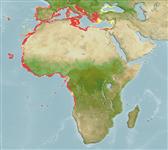Environment: milieu / climate zone / depth range / distribution range
Ecologie
marien demersaal; diepte 15 - 400 m (Ref. 26999). Subtropical; 45°N - 15°S, 26°W - 36°E
Eastern Atlantic: Mediterranean and the Adriatic Sea (Ref. 12382); Mauritania to Angola, including Madeira, Cape Verde and the Canary Islands (Ref. 5979).
Lengte bij maturiteit / Grootte / Gewicht / Leeftijd
Maturity: Lm 20.4 range ? - ? cm
Max length : 45.0 cm TL mannelijk / geslacht onbekend; (Ref. 27584); common length : 13.0 cm TL mannelijk / geslacht onbekend; (Ref. 3397); max. gepubliceerd gewicht: 700.00 g (Ref. 27584); max. gerapporteerde leeftijd: 6 Jaren (Ref. 127561)
Dorsale zachte stralen (totaal): 85-95; Anale zachte stralen: 63 - 73. The scales on the eyed side are ctenoid and cycloid on the blind side. The inter-orbital width is much wider in males. The upper pectoral fin rays are not prolonged. The subspecies in the Mediterranean and African coast, P. podas has 75-86 lateral line scales, with 13-20 scales making up the curved portion. Its eyed side has alight brown color, bearing darker spots. The subspecies in Madeira and the Canaries, B. p. maderensis, has 88-91 lateral line scales, with 20-21 on the lateral line curve. Its eyed side appears dark brown to dark violet and seldom spotted.
Found in shallow waters, over sandy and muddy bottoms of the continental plateau (Ref. 5377, 12382). Feeds on benthic small fishes and invertebrates. Reproduction occurs between May and August. Small individuals adapt well in aquariums but require sufficient bottom areas (Ref. 12382).
Aldebert, Y., M. Desoutter and J.-C. Quéro, 1990. Bothidae. p. 1027-1036. In J.C. Quero, J.C. Hureau, C. Karrer, A. Post and L. Saldanha (eds.) Check-list of the fishes of the eastern tropical Atlantic (CLOFETA). JNICT, Lisbon; SEI, Paris; and UNESCO, Paris. Vol. 2. (Ref. 5979)
Status op de Rode Lijst van het IUCN (Ref. 130435)
Gevaar voor de mens
Harmless
Gebruik door de mens
Visserij: commercieel; Aquarium: Commercieel
Meer informatie
ReferentiesAquacultuurAquacultuurprofielKweeklijnenGeneticaElectrophoresesErfelijkheidZiektesVerwerkingNutrientsMassaconversie
Tools
Speciale rapporten
Download XML
Internetbronnen
Estimates based on models
Preferred temperature (Ref.
123201): 13 - 17.6, mean 15.1 °C (based on 199 cells).
Fylogenetische diversiteitsindex (Ref.
82804): PD
50 = 0.5000 [Uniqueness, from 0.5 = low to 2.0 = high].
Bayesian length-weight: a=0.00871 (0.00648 - 0.01170), b=3.07 (3.01 - 3.13), in cm total length, based on LWR estimates for this species (Ref.
93245).
Trofisch niveau (Ref.
69278): 3.4 ±0.4 se; based on diet studies.
Weerstandsvermogen (Ref.
120179): Gemiddeld, minimale populatieverdubbelingstijd 1,4-4,4 jaar (K=0.43).
Fishing Vulnerability (Ref.
59153): Low to moderate vulnerability (35 of 100).
Nutrients (Ref.
124155): Calcium = 68.8 [28.8, 130.4] mg/100g; Iron = 0.851 [0.417, 1.517] mg/100g; Protein = 17.9 [16.6, 19.3] %; Omega3 = 0.212 [0.112, 0.389] g/100g; Selenium = 37.7 [18.6, 80.9] μg/100g; VitaminA = 9.51 [2.40, 36.37] μg/100g; Zinc = 0.65 [0.44, 0.94] mg/100g (wet weight);
